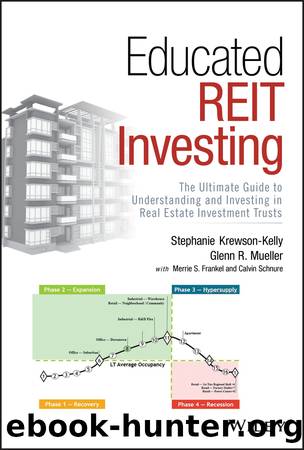Educated REIT Investing by Stephanie Krewson-Kelly & Glenn R. Mueller

Author:Stephanie Krewson-Kelly & Glenn R. Mueller [Krewson-Kelly, Stephanie & Mueller, Glenn R.]
Language: eng
Format: epub
ISBN: 9781119708711
Publisher: Wiley
Published: 2020-09-29T00:00:00+00:00
OP UNITS POSSIBLE CONFLICTS WITH PORTFOLIO MANAGEMENT
The creation of the UPREIT structure was a watershed event that directly contributed to the REIT industry's rapid growth, particularly in the 1990s. As Table 1.1 in Chapter 1 shows, the market capitalization of equity REITs increased dramatically from $9 billion at the end of 1991 (before UPREITs) to $147 billion at the end of 2001, representing compound annual growth of 32.6%. As beneficial as the UPREIT structure has been to the REIT industry's growth, investors should be aware of the little-understood but key element the UPREIT tax-deferral structure includes that can generate potential conflicts of interest between the UPREIT partnership unitholders and the REIT's common shareholders. Specifically, the UPREIT takes the property(s) contributed in exchange for partnership units at the new acquisition price basis for tax purposes, and the old, lower tax basis and the related tax deferral remains with the property contributor (seller). Consequently, if the REIT resells the asset, the tax indemnification clause in the 721 Exchange means not only that the resale of the property will trigger the full deferred tax liability, but also that the REIT (not the original seller) will have to pay it.
For this reason every UPREIT transaction between a REIT and contributing partners includes a tax indemnification clause stating that if the REIT sells the acquired asset during a specified period of time, typically five, seven, or ten years (with the predominate number of lock-up years being seven), the REIT must either (1) perform a 1031 Exchange with proceeds from the sale of the original asset into a replacement property in order to continue deferring the seller/contributors' tax liability; or (2) pay the taxes incurred by the original contributor that arise out of the property sale. This UPREIT sale clause is overt â that is, everyone knows that a contributed asset will not likely be sold during the lockup period. This understanding is a possible negative in terms of portfolio management flexibility in that the REIT's leadership is incentivized to manage its portfolio with consideration of external tax impacts. The more insidious conflict element in UPREIT transactions is that if management and/or the board is the property contributor, which is often the case, they remain personally on the hook for the deferred tax liability even after the asset lockup period burns off; the conflict is that they may be motivated to hold on to properties that in an unconflicted scenario the REIT might otherwise decide to sell, in some cases holding on to properties that are well past their âsell-byâ date just to avoid paying taxes.
As time passes, the tax encumbrances associated with many 721 Exchanges burn-off. Additionally, there are some instances where an UPREIT's management team has negotiated only a âbest effortâ not to resell an asset until after a certain number of years, leaving them fundamentally free to resell the asset if that is the correct asset management tactic. Accordingly, not every UPREIT has tax-impaired properties embedded in its OP â but investors should
Download
This site does not store any files on its server. We only index and link to content provided by other sites. Please contact the content providers to delete copyright contents if any and email us, we'll remove relevant links or contents immediately.
| Buying & Selling Homes | Investments |
| Law | Mortgages |
| Sales |
Investing For Dummies by Eric Tyson(2470)
The Book on Rental Property Investing by Turner Brandon(1402)
The Book On Tax Strategies for the Savvy Real Estate Investor by Amanda Han & Matthew MacFarland(1337)
Every Landlord's Legal Guide by Janet Portman & Stewart Marcia & Ralph Warner(1322)
The Thibaults by Roger Martin Du Gard(1305)
Personal Finance For Dummies (9th Edition) by Eric Tyson(1272)
Real Estate Licensing Exams by Raymond D. Modglin(1149)
Investing 101 by Michele Cagan(1090)
Bill Bryson by At Home(1068)
The Real Book of Real Estate by Robert T. Kiyosaki(1033)
The Plaza by Julie Satow(1031)
Irrational Exuberance by Shiller Robert J. J(1026)
7 Steps to Wealth by John L. Fitzgerald(966)
Mortgages 101 by David Reed(961)
Real Estate Math Demystified by Steven P. Mooney(949)
The Business of Flipping Homes by William Bronchick(942)
Now I Sit Me Down by Witold Rybczynski(921)
Retail Development by Anita Kramer(908)
SAP Flexible Real Estate Management by Jayant Daithankar(905)
